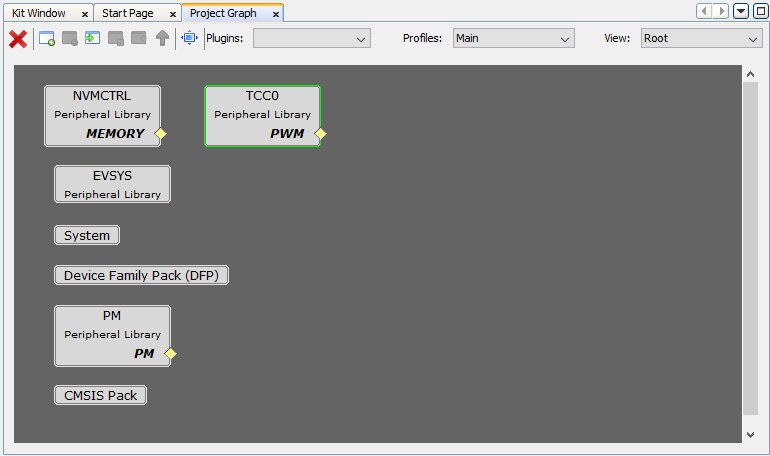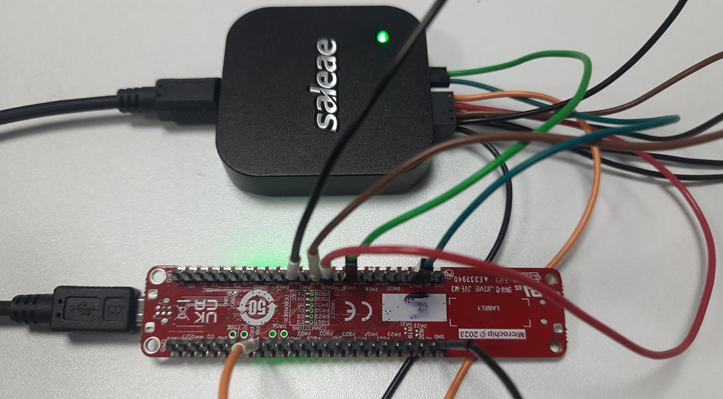3.6.3.1.14 TCC PWM Generation on PIC32CM LS00 Curiosity Nano+ Touch Evaluation Kit
Description
This application example shows how to use Timer Counter for Control Applications (TCC) module to generate PWM signals. The TCC is configured to generate synchronous 2 or 3 phase PWM signals with dead time. The duty cycle of the PWM signals is updated in the period interrupt handler.
Modules/Technology Used
- Peripheral Modules
- TCC0
- PM
- EVSYS
- NVMCTRL
- PORT
The MCC Harmony project graph would look like this:
Hardware Used
Software/Tools Used
This project has been verified to work with the following versions of software tools:
Refer Project Manifest present in harmony-manifest-success.yml under the project folder firmware\tcc_timer_mode\src\config\pic32cm_ls00_cnano.
- Refer the Release Notes to know the MPLAB X IDE and MCC Plugin version.
Because Microchip regularly updates tools, occasionally issue(s) could be discovered while using the newer versions of the tools. If the project does not seem to work and version incompatibility is suspected. It is recommended to double-check and use the same versions that the project was tested with. To download original version of MPLAB Harmony v3 packages, refer to document How to Use the MPLAB Harmony v3 Project Manifest Feature (DS90003305).
Setup
- Connect the PIC32CM LS00 Curiosity Nano+ Touch Evaluation Kit to the Host PC as a USB Device through a Type-A male to micro-B USB cable connected to Micro-B USB (Debug USB) port.
- To establish the connection with the
Saleae Logic Analyzer to the Host PC.
Table 3-1. Pin Details Signal Name Pad ch0-PWMH PA08 ch0-PWML PA09 ch1-PWMH PA10 ch1-PWML PA14 ch2-PWMH PA15 ch2-PWML PA16 
Programming hex file
The pre-built hex file can be programmed by following the below steps.
- Open MPLAB X IDE
- Close all existing projects in IDE, if any project is opened.
- Go to File -> Import -> Hex/ELF File
- In the Import Image File
window,
- Create Prebuilt Project,
- Click the Browse button to select the prebuilt hex file.
- Select Device as PIC32CM5164LS00048.
- Ensure the proper tool is selected under Hardware Tool and click on Next button.
- Select Project Name and Folder,
- Select appropriate project name and folder and click on Finish button
- Create Prebuilt Project,
- In MPLAB X IDE, click on Make and Program Device button to program the device.
Programming/Debugging Application Project
- Open the project (tcc_synchronous_pwm_channels\firmware\tcc_timer_mode) in MPLAB X IDE.
- Ensure PIC32CM LS00 Curiosity Nano is selected as hardware tool to program/debug the application.
- Build the code and program the device by clicking on the Make and Program button in MPLAB X IDE tool bar.
- Follow the steps in Running the Demo section below.
Running the Demo
- Open the Saleae logic application on the PC (from the Windows® Start menu by pressing the Start button).
- Observe the PWM frequency to be 10 kHz.
Logic Analyzer Output
- The following high-side and low-side PWM waveforms are displayed on the Logic Analyzer.
- Observe the dead time between the
high side and the low side.

Comments
- Reference Training Module: Arm TrustZone Getting Started Application on PIC32CM LS60 (Arm Cortex-M23) MCUs.
- This application demo builds and
works out of box by following the instructions above in Running the Demo
section. If the user needs to enhance/customize this application demo, should use the
MPLAB Harmony v3 Software framework. Refer links below to setup and build the
applications using MPLAB Harmony.
- How to Setup MPLAB Harmony v3 Software Development Framework (DS90003232).
- How to Build an Application by Adding a New PLIB, Driver, or Middleware to an Existing MPLAB Harmony v3 Project (DS90003253).
- How to Set up the Tools Required to Get Started with MPLAB® Harmony v3 and MCC
- Create a new MPLAB Harmony v3 project using MCC
- Update and Configure an Existing MHC-based MPLAB Harmony v3 Project to MCC-based Project
